Pass Manchac Light
Pass Manchac Light was a historic lighthouse in Tangipahoa Parish, Louisiana, which was originally established in 1838, to mark the north side of the entrance to Pass Manchac, the channel between Lake Pontchartrain and Lake Maurepas. The fourth and last tower on this particular site was constructed in 1857 and was in service for 130 years. The first three had been built in 1838, 1842, and 1846, in each case requiring replacement due to poor construction and/or encroaching lake waters.[2]
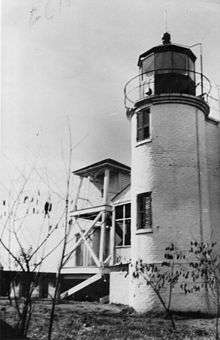 | |
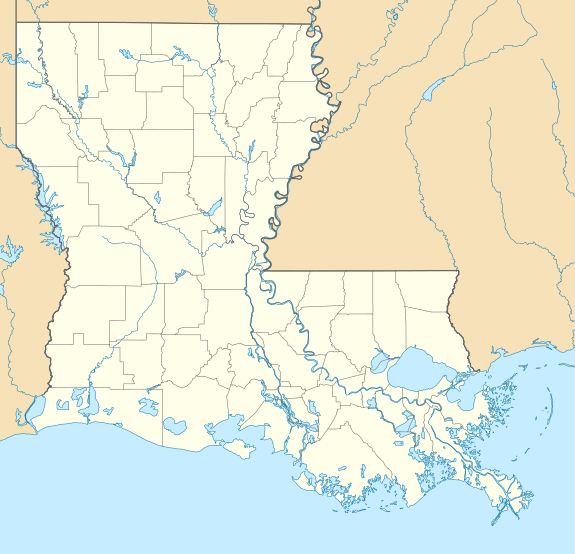 | |

| |
| Location | Pass Manchac, Lake Pontchartrain, Louisiana |
|---|---|
| Coordinates | 30°17′48.1″N 90°17′53.7″W |
| Year first constructed | 1837 |
| Year first lit | 1857 |
| Automated | 1941 |
| Deactivated | 1987 |
| Foundation | Stone |
| Construction | Brick |
| Tower shape | Cylindrical |
| Markings / pattern | White |
| Tower height | 40 feet (12 m) |
| Original lens | 4th order Fresnel lens |
| Characteristic | Pre 1865: Fixed red Later: Fixed white |
| Fog signal | 1,200 pounds (540 kg) mechanical bell, 1898 |
| ARLHS number | USA-582 (historic light) |
| USCG number | 4-10422 (current skeleton tower)[1][2][3][4][5] |
Pass Manchac Light | |
Formerly listed on the U.S. National Register of Historic Places | |
| Nearest city | Ponchatoula, Louisiana |
| Area | less than one acre |
| Built | 1857 |
| Architectural style | Masonry lighthouse |
| NRHP reference No. | 86001554[6] |
| Significant dates | |
| Added to NRHP | July 09, 1986 |
| Removed from NRHP | January 31, 2019 |
History
The 1857 lighthouse, a brick cylinder with attached house, was damaged in the Civil War and during tropical storms in 1888, 1890, 1915, 1926, and 1931. The station was automated in 1941, and the keeper's house was removed in 1952, by which time the light was on an island instead of a peninsula.[2]
Pass Manchac Light was added to the National Register of Historic Places in 1986. The light was functionally replaced in 1987 by the U.S. Coast Guard, which established a skeleton tower on the south side of the pass entrance.[1]
On August 28, 2012, Louisiana was struck by Hurricane Isaac, destroying the lighthouse. It was removed from the National Register in January 2019.
However, since February 2008 its lantern room – which was removed from the tower in 2002 for restoration – has been located at the Lake Pontchartrain Basin Maritime Museum, in Madisonville, Louisiana.[7]
Gallery
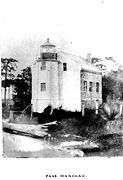 19th century
19th century 1914[8]
1914[8]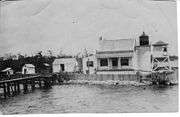 1918
1918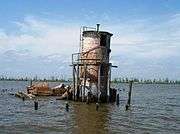 2011
2011
See also
References
- "Lakes Pontchartrain and Maurepas, 1/80,000". Chart. NOAA. 11369. 2005.
- "Historic Light Station Information and Photography: Louisiana". United States Coast Guard Historian's Office. Archived from the original on 2017-05-01.
- "Pass Manchac Light". Inventory of Historic Light Stations: Louisiana Lighthouses. National Park Service. Retrieved 12 January 2010.
- Rowlett, Russ (2010-01-11). "Lighthouses of Louisiana". The Lighthouse Directory. University of North Carolina at Chapel Hill.
- Light List, Volume IV, Gulf of Mexico (PDF). Light List. United States Coast Guard. 2009. p. 86.
- "National Register Information System". National Register of Historic Places. National Park Service. March 13, 2009.
- Pass Manchac at LighthouseFriends.com accessed 25 Mar 2015.
- "Pass Manchac Lighthouse". LighthouseFriends.
External links
- Pass Manchac at Lighthouse Friends detailed history
- 1996 video of the Pass Manchac Light
- Website of Lake Pontchartrain Basin Maritime Museum in Madisonville, Louisiana